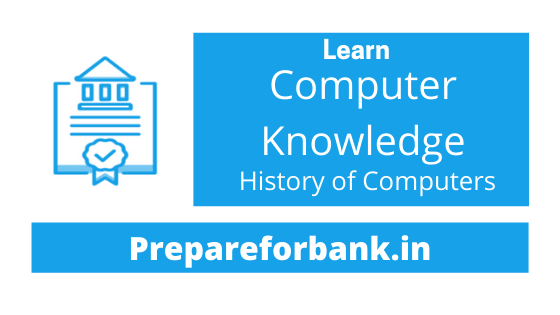It is important to know Computer Awareness For Bank Exam, as we must be aware of its origin and development. Computers are becoming our day-to-day part of life and luxury, so it’s essential to learn and gain knowledge about new inventions in computers and their related world.
Learning the history of computers helps in understanding the present situation, and motivates innovation. Nowadays history of computers is an essential topic to be learned and understood for the preparation of bank exams such as IBPS or SBI.
An English mechanical engineer and polymath “Charles Babbage“, originated the concept of a programmable computer. He is also known as the “father of the computer“.
Early computers were only known for calculation. Earlier simple manual devices like the abacus aided people in doing calculations.

Table of Contents
Computer Awareness For Bank Exam
The First Computer
Generations
- 1st Generation – The period of first-generation started from 1946-1959 and were vacuum tube-based.
- 2nd Generation – The period of second generation started from 1959-1965 and where transistor based.
- 3rd Generation – The period of third generation started from 1965-1971 and where integrated Circuit based.
- 4th Generation – The period of fourth generation started from 1971-1980 and where VLSI microprocessor based.
- 5th Generation – The period of fifth generation started from 1980- onwards and are ULSI microprocessor based.
Analog Computer
An Analog computer processes analog data. These store data in a continuous form of physical quantities which perform calculations with the help of measures.
It is quite different from the digital computer, which makes use of symbolic numbers to represent results.
The Earliest computer machine developed was the analog computer which was the most complicated machine for analog computation and process control. Example of data are : pressure, voltage, temperature, speed and weight.
Digital Computer
An Digital computer is a device that processes information by manipulating symbols according to logical rules. The digital computers use the binary number system, which has two digits: 0 and 1.A binary digit is called a bit.
Digital computers are available in variety of types, mainly from tiny, special-purpose devices embedded in cars and other devices which are familiar desktop computer, the minicomputer, the mainframe, and the supercomputer.
Modern Computer
Modern computer is consist of hardware and software components. Hardware refers to the part of the computer that has a physical component, mainly a keyboard or a mouse, whereas software is set of instructions that tells the hardware how to complete each task.
Modern computers are available in the form of desktop and laptop computers. Desktop computers are usually used at work, home, school or the library and are easy to upgrade.
On the other hand, Laptop computers are battery computers which are more portable than desktop computers, but cannot be easily upgraded.
Architecture
Computer architecture is a science or a set of rules stating how computer software and hardware are joined together and interact to make a computer work. It determines how the computer works and also which technology the computer is capable.
By Size –
Super – This computer is high level of performance compared to general-purpose computer.
Mainframe – These type of computers are generally known for large size, amount of storage, processing power and high level of reliability. These computers are largely used by organisations for mission-critical applications which require high volume of data processing.
Mini – These type of computers are smaller in size but it possesses most of the features and capabilities of a large computer. It fills the gap between the mainframe and microcomputer, and is smaller than the former but larger than the latter.
These type of computers are used as small or mid-range servers which operates business and scientific applications.
Personal Computer –
Desktop – Desktops are large in size and have a separate monitor. Desktop can be taken from one place to another place but not the choice for portability.
A Desktop has a separate monitor, keyboard, CPU to be connected and carried together. It is commonly referred to as a physical computer unit, as well as a graphical user workspace on a software operating system like the Windows Desktop.
Laptop – Laptops are very portable due to their compact size. Its designed in such a way that it can be taken from place to place and can be carried in a backpack or laptop carrying case.
It has a built-in monitor, keyboard, and typically a touchpad. It can also be connected by external peripherals using different cable connections, depending on which ports are provided by the manufacturer.
Hardware
It includes the physical parts of a computer, such as a case, (CPU)central processing unit, (Screen)monitor, mouse, keyboard, computer data storage, graphics card, sound card, speakers, and motherboard.
I/O device or Input/Output device
(I/O) device is also known as input/output hardware device which has the ability to accept input data, output data or other processed data.
Input devices provide input, while output devices provide a way for a computer to output data for communicating with users or other computers.
I/O storage devices are CD/DVD-ROM drives, USB flash drives and hard disk drives. I/O communicating devices are network adaptors, Bluetooth adaptors/dongles and modems.
CPU or Central Processing Unit
CPU is the brain of the computer. It performs all types of data processing operations.It stores data, intermediate results, and instructions(program). Operations of all parts are controlled by CPU. CPU or Central Processing Unit has following three components.
Memory – It can store instructions, data, and intermediate results.
It is also known as internal storage unit, the main memory, the primary storage or Random Access Memory (RAM).
Primary and secondary memory are 2 types of memories in the computer. Its stores and process instructions of data that is required for processing.
Control Unit – CU or Control Unit extracts instructions from memory, decodes them and executes them and calls ALU when necessary.
ALU or Arithmetic Logic Unit – It consists of two subsections namely,
Arithmetic Section and Logic Section.
Arithmetic Section – Its function is to perform arithmetic operations like addition, subtraction, multiplication, and division and performs all
complex operations by making repetitive use of the above operations.
Logic Section – Its function is to perform logic operations such as comparing, selecting, matching, and merging of data.
Software
Software is a collection of data or computer instructions that tell the computer how to work. Everything that “runs” on a computer, from an operating system, to a diagnostic tool, video game, or app can be defined as software.
Languages – It is the language through which we can communicate to computers. There are mainly 3 different languages
Machine level language – Computer can understand only the language of Digital Electronics. Digital Electronics deals with presence and absence of voltages.
Assembly level language – Assembly language uses mnemonics or symbolic instructions in place of a sequence of 0s and 1s.
For example, we can consider that, to add register A and B in a particular computer, assembly language uses the mnemonic ‘ADD B’ in place of 10001111
High level language – High level language is the next development in the evolution of computer languages.
For example, PROLOG as PROGRAMMING LOGIC, FORTRAN as FORMULA TRANSLATION, LISP as LIST Processing, Pascal (named after the French scientist Blaise Pascal).

